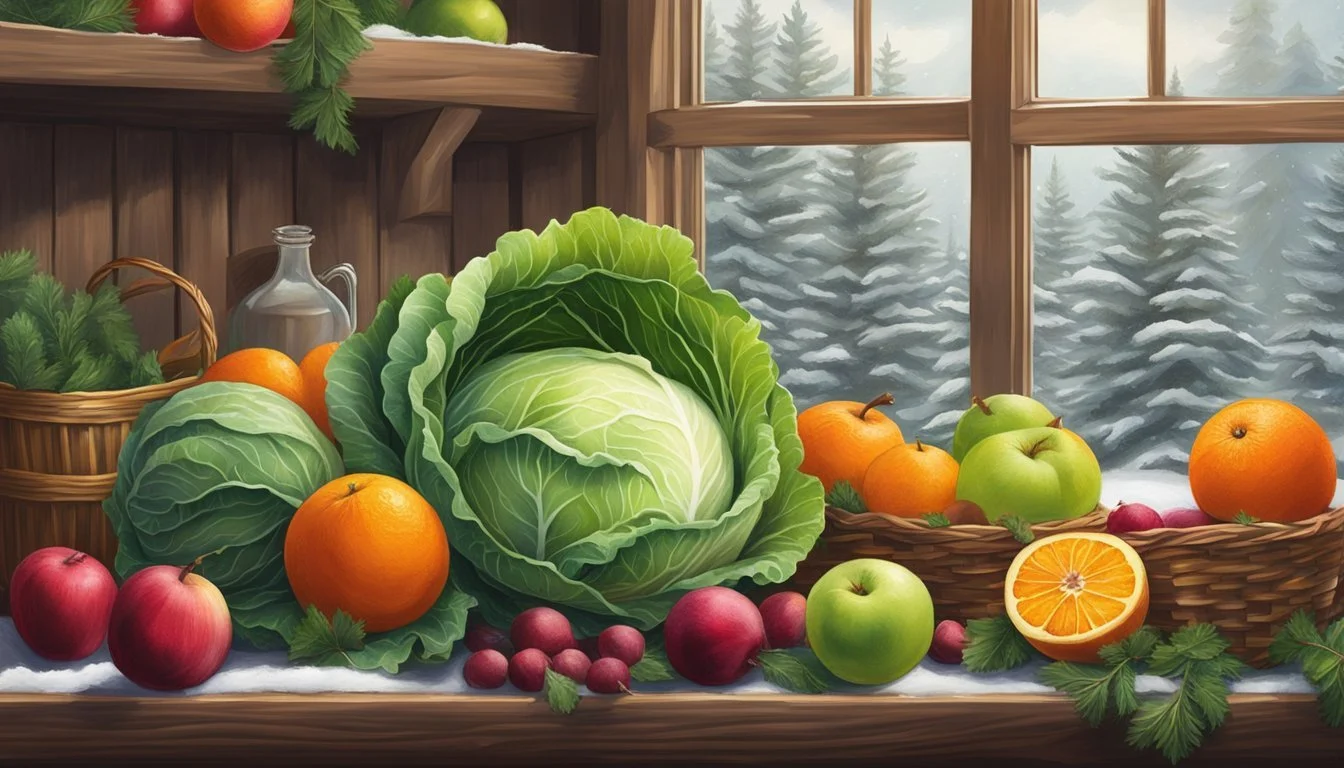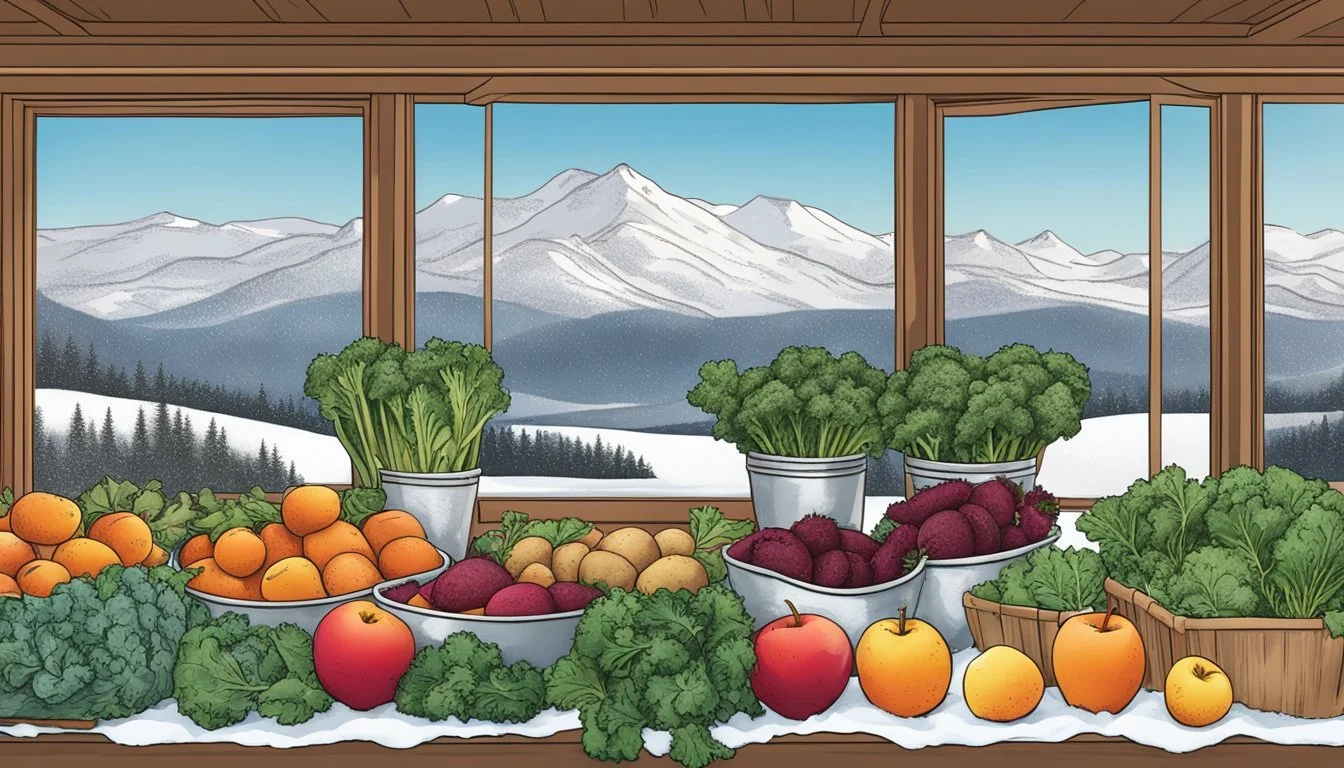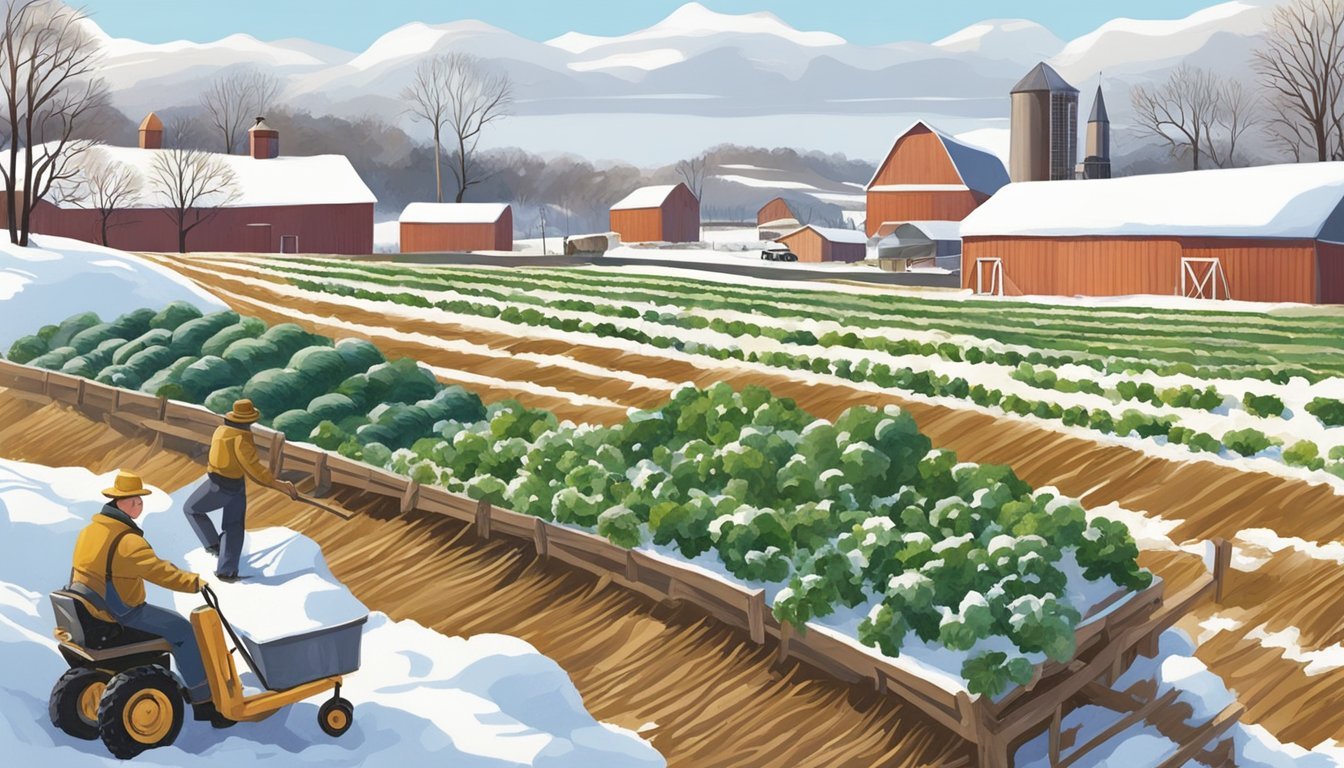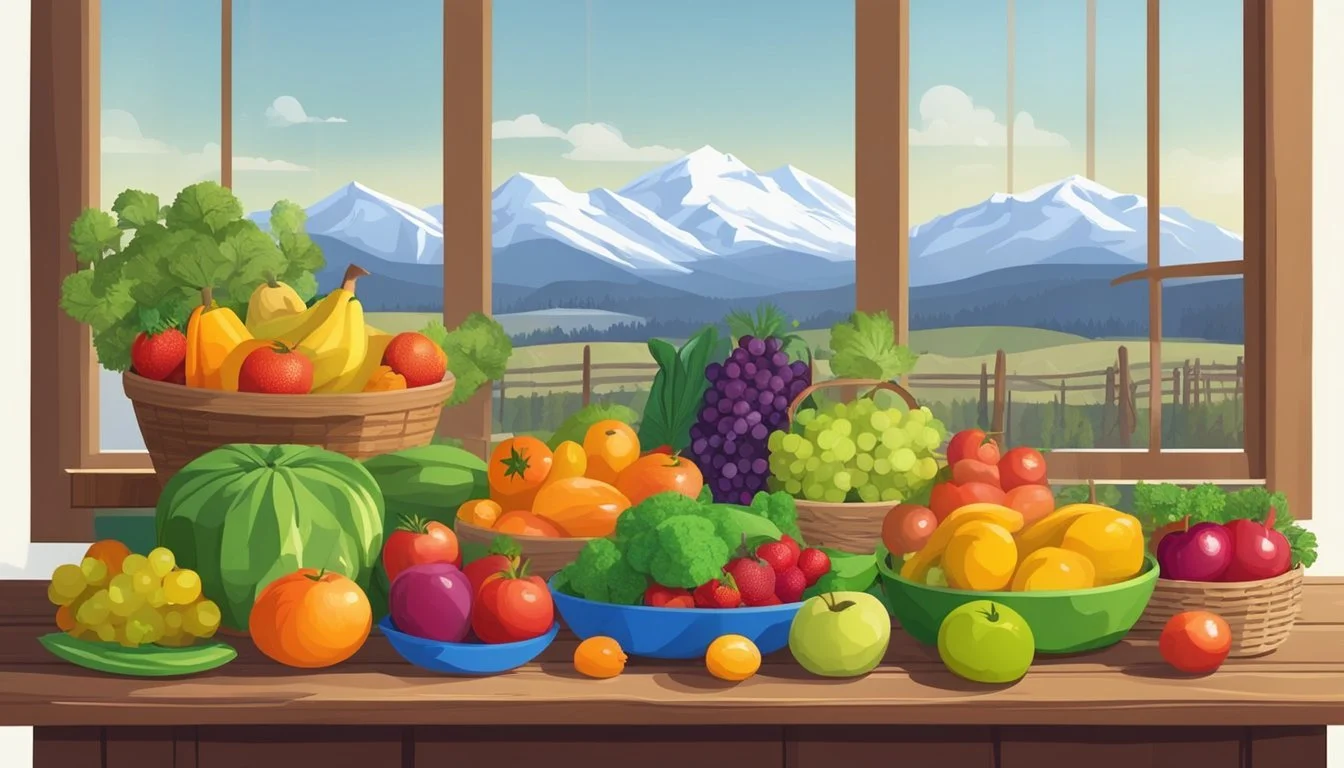West Virginia Seasonal Fruit & Vegetables in February
A Guide to Winter Produce
This Article is Part of our West Virginia Seasonal Fruit & Veg Calendar
In the heart of winter, February in West Virginia offers a modest but distinct variety of fruits and vegetables. The season's cold grip limits local produce; however, the state's farmers' markets and supermarkets still provide some fresh options for residents. While the selection is not as vast as the summer months, there is a certain charm to the hardy produce that can be found during this time of the year.
Fruits available in February are typically those capable of withstanding cooler temperatures or those that are stored well from previous harvests. Apples remain a staple, thanks to their longevity post-harvest, and citrus fruits like clementines and grapefruits are often at peak sweetness. These fruits not only add a splash of color to the winter palette but also offer refreshing flavors that contrast the heavier winter meals.
The vegetable offerings are hardy greens and root vegetables that can tolerate the cold or are stored from fall harvests. Collard greens, kale, (What wine goes well with kale?) and other leafy greens are in good supply, providing essential nutrients and a burst of green amidst the more subdued winter colors. Root vegetables like turnips and potatoes are also commonly found, as they store well and can be used in a variety of warming dishes suitable for cold February days.
Benefits of Seasonal Eating
Seasonal eating in West Virginia during winter emphasizes consuming produce that naturally comes to harvest during this time. This practice often leads to benefits that are nutritional, environmental, and economic in nature.
Health and Nutrition
In winter, the availability of certain fruits and vegetables may be limited; however, those that are in season can offer enhanced flavor and nutrient density. Root vegetables and winter greens, prevalent in this season, typically contain high levels of vitamins and essential minerals. For example, kale and brussels sprouts (how long do brussels sprouts last?) thrive in the cold and can provide significant amounts of Vitamin K and antioxidants.
Environmental Impact
Eating seasonally and locally reduces the carbon footprint associated with transporting food over long distances. Winter-season produce in West Virginia, like other regions, tends to travel shorter distances from farm to table. This practice supports sustainability by lessening fuel consumption and pollution. Additionally, seasonal fruits and vegetables require less energy for storage and preservation, further decreasing environmental impact.
Economic Advantages
When consumers choose seasonal produce, they support West Virginia's economy and local farmers. Demand for seasonal fruits and vegetables can lead to financial stability for farmers and the success of local businesses tied to agriculture. Additionally, seasonal foods often cost less due to reduced transportation and storage needs, providing an economic benefit to the consumer.
Winter Produce in West Virginia
In February, West Virginians enjoy a selection of hardy winter produce that thrives despite the chilly weather. While many typical summer fruits are out of season, the colder months offer their own variety of fresh, nutritious options.
Fruits Available
Apples: Even as winter persists, stored apples from the fall harvest remain crisp and flavorful.
Vegetables in Season
Winter Squash: Varieties like butternut and acorn squash are available, offering a sweet and filling option.
Leafy Greens: Hardy greens such as kale can withstand the cold and provide fresh offerings.
Root Vegetables:
Sweet Potatoes (What wine goes well with sweet potatoes?): These tubers store well and continue to be available.
Beets (how long do beets last?): Root vegetables like beets are resilient in colder temperatures.
Carrots (how long do carrots last?): Carrots, often sweetened by a touch of frost, are harvested in winter as well.
Cabbage: This versatile vegetable remains in season and can be used in a plethora of dishes.
Onions: Stored from the fall, onions are a staple through the winter months.
Broccoli (how long does broccoli last?): Although it is more of a cool weather crop, it may still be available from storage or late winter harvests.
Celery: While not typically a winter crop, if grown in controlled conditions, it might also be found in markets.
Seasonal Recipes Ideas
February's bounty in West Virginia offers an array of fresh fruits and vegetables that can be used to create comforting main dishes, satisfying side dishes, and delicious desserts and preserves. With ingredients like sweet potatoes, beets, kale, and apples, cooks can prepare nutritious and flavorful meals.
Main Dishes
West Virginians often utilize hearty root vegetables and dark leafy greens to craft nourishing main courses. Here are a few ideas:
Sweet Potato & Kale Stew: This savory stew combines the sweetness of locally-grown sweet potatoes with the earthiness of kale, seasoned with a hint of garlic and thyme.
Beet and Goat Cheese Risotto: A rich, creamy dish featuring roasted beets, tangy goat cheese, and arborio rice—a delightful blend of flavors and textures.
Side Dishes
Side dishes in West Virginia take full advantage of the seasonal produce:
Roasted Root Vegetables: A mix of carrots, turnips, and beets, tossed with olive oil, salt, and pepper, roasted to perfection makes for a simple, yet satisfying side.
Braised Cabbage with Apples: Sauteed with onions, apples, and a touch of cider vinegar, this dish highlights the natural sweetness and tanginess of the ingredients.
Desserts and Preserves
Sweet treats and preserves highlight the seasonal fruits:
Apple Crisp: Combining the tartness of local apples with a crumbly topping of oats (how long do oats last?), butter, and cinnamon, this dessert is a true comfort in the cold month of February.
Carrot Cake: Grated carrots, walnuts, and spices come together in this moist, classic cake, often crowned with a creamy frosting.
Growing and Harvesting Calendar
In West Virginia, February is a month of transition in the agricultural calendar, marking the end of winter harvesting and the beginning of spring planting preparations. Farmers carefully monitor the seasons to plan their crops for optimal growth and yield.
Winter Harvesting
During February, West Virginia's climate typically limits the variety of crops ready for harvest. However, hardy winter vegetables like parsnips and garlic may still be collected, as they are resilient against the cold:
Parsnips: These can be left in the ground and harvested throughout the winter as needed.
Garlic: If planted the previous fall, garlic lies dormant in February but is nearing the end of its winter growing phase.
Planning for Spring Planting
Farmers in West Virginia use February to strategize for the upcoming spring planting. By the end of the month and into early March, preparations begin for planting a variety of crops. Key considerations include:
Frost-Free Dates: Knowledge of local frost dates is crucial. For example, Zone A generally has a frost-free date around May 10, while Zone B is around April 30.
Growing Seasons: Different regions in the state have varying lengths of growing seasons, with Zone A experiencing approximately 145 days and Zone B around 160 days.
Farmers might begin indoor seeding of certain crops in anticipation of transplanting them outdoors once the risk of frost has passed. The planning also includes identifying which crops will be planted in the upcoming season based on the expected weather patterns and historical climate data.
Storing and Preserving Tips
Proper storage and preservation of fruits and vegetables are crucial for maintaining freshness and nutritional quality. In West Virginia, February's harvest includes root vegetables and hearty greens, which can be kept at peak condition using the following techniques.
Cold Storage
The key to cold storage is maintaining a consistent, cool temperature and proper humidity.
Potatoes: Store in a dark, cool place at around 45-50°F. Do not refrigerate, as cold temperatures convert starch to sugar.
Squash: Requires a slightly warmer storage temperature, roughly 50-55°F, with good air circulation.
Broccoli and Cauliflower: These should be kept in a refrigerator, preferably in a crisper drawer, with a temperature around 32-35°F.
Greens: Like kale and collard greens from the local February harvest are best stored in the refrigerator, loosely wrapped in a damp paper towel.
Fruits:
Apples: Ideal for cold storage; keep them at 30-35°F with 90-95% humidity, separate from vegetables.
Freezing Techniques
Freezing preserves most of the nutritional content of fruits and vegetables and is simple to execute.
Fruits: Berries, and sliced apples, should be washed, thoroughly dried, and spread on a baking sheet to freeze individually. Once frozen, transfer them to airtight containers or freezer bags.
Vegetables: Most, including broccoli and cauliflower, should be blanched first to stop enzyme activity, cooled rapidly, dried, and then frozen in the same manner as fruits. Blanching times vary, but generally, it's a few minutes in boiling water followed by a quick transfer to ice water.
Note: When freezing any produce, label containers with the date of freezing to ensure proper rotation and usage.
Finding Local Produce
In February, residents of West Virginia can access a variety of local produce through farm markets and CSA programs. These channels support state farmers and provide consumers with fresh, seasonal crops.
Farm Markets and Stands
West Virginia boasts numerous farm markets and stands throughout the state, offering seasonal fruits and vegetables even during the cooler months. These markets are integral to supporting local farmers and tend to provide a wide range of produce. A map of local farm markets can often be procured from the West Virginia Department of Agriculture, or by visiting each market's respective website.
Available Produce: This can vary depending on the specific market or stand, but February selections may include storage crops and greenhouse-grown produce.
Community Supported Agriculture (CSA)
Community Supported Agriculture programs are a popular way for consumers to buy seasonal food directly from local farmers in West Virginia. By purchasing a share of the harvest, consumers receive regular deliveries or pickups of fresh produce throughout the farming season, which includes winter months for some hardy crops and greenhouse offerings.
Benefits: Joining a CSA promotes the local economy, ensures fresh produce, and supports sustainable agriculture practices within the state.
Seasonality and Health Facts
In February, West Virginia's seasonal produce is sparse due to the winter climate; however, the available fruits and vegetables such as root vegetables and hardy greens still provide important nutritional benefits. This selection aligns with dietary recommendations for consuming a variety of produce year-round.
Nutrition Information
Root Vegetables:
Sweet Potatoes: Rich in beta-carotene, vitamin C, and fiber.
Carrots: Offer an excellent source of vitamin A, antioxidants, and dietary fiber.
Fruits:
Apples: They are typically stored from the fall and are a good source of fiber and vitamin C.
Greens:
Kale: High in vitamins K, A, and C, along with being a good source of minerals like manganese.
Collard Greens: Provide vitamins A, C, and K, calcium, iron, and fiber.
These selections not only support the immune system during the colder months but also contribute to a balanced diet.
Dietary Recommendations
Seasonal Vegetables and Fruits:
Eating seasonally available vegetables like squash, sweet potatoes, carrots, and the limited selection of winter greens such as kale ensures freshness and optimal nutrient content.Balanced Diet:
Including a variety of these vegetables in one's diet can contribute to overall health. For instance:Greens: Incorporating greens like kale and collard greens can help meet the dietary recommendation for leafy vegetables.
Fiber-Rich Foods: Root vegetables and apples, which are available during this season, serve as important fiber sources.
Introducing these foods into regular meals aligns with dietary guidelines that suggest a diet rich in fruits and vegetables, aiding in maintaining health through the winter season.
Conclusion
West Virginia’s adherence to seasonal eating during the month of February focuses on sustainability and supports local farmers. Consumers typically find an array of root vegetables and brassicas, which are not only hardy against the cold but also become sweeter post-frost, offering a rich culinary experience.
Local Produce Highlights in February:
Root vegetables: carrots, beets, and potatoes
Brassicas: kale, Brussels sprouts, and cauliflower
Embracing the season's offerings means participating in a cycle that is beneficial for both the environment and the local economy. Residents and visitors have the opportunity to indulge in wholesome, nutritious produce right from their backyard, all while fostering a strong community rooted in agricultural heritage.
Local markets adjust their offerings as the weather transitions from winter to early spring, providing shoppers with insights on the natural growing cycles. This month, while certain crops may only be available in limited quantities, the selection available is at its peak in flavor and nourishment.
In essence, West Virginia's seasonal produce in February reflects an enduring commitment to the environment and community. As the state's family-owned farms continue to thrive, they offer a monthly rotation of fresh, local, and sustainable options that mirror the ebb and flow of nature's own calendar.










